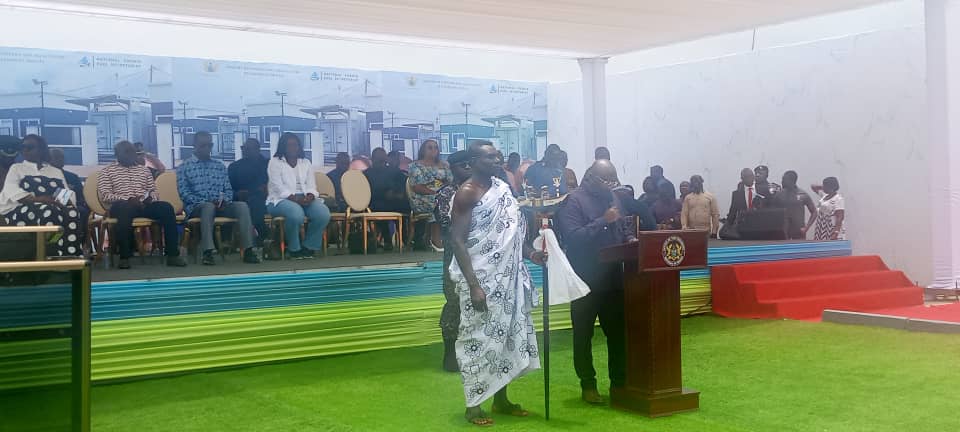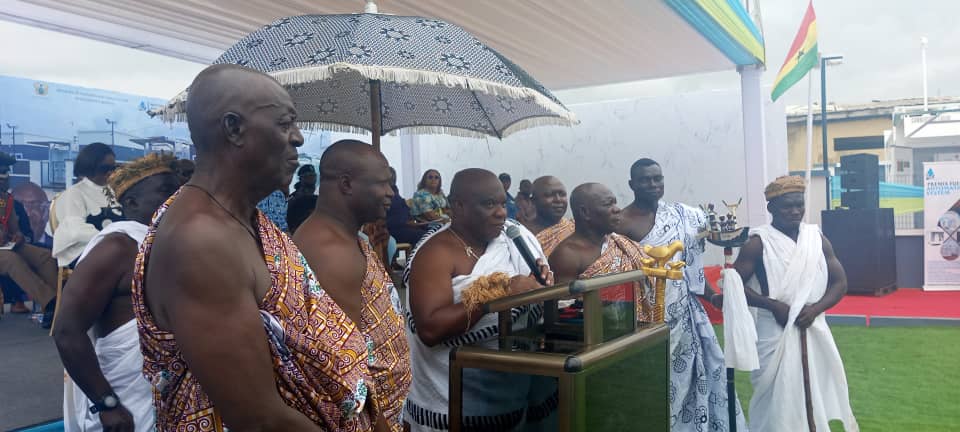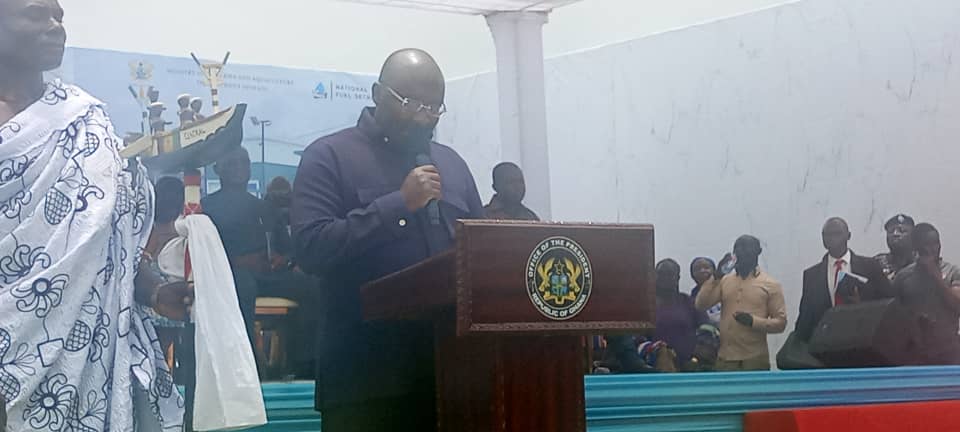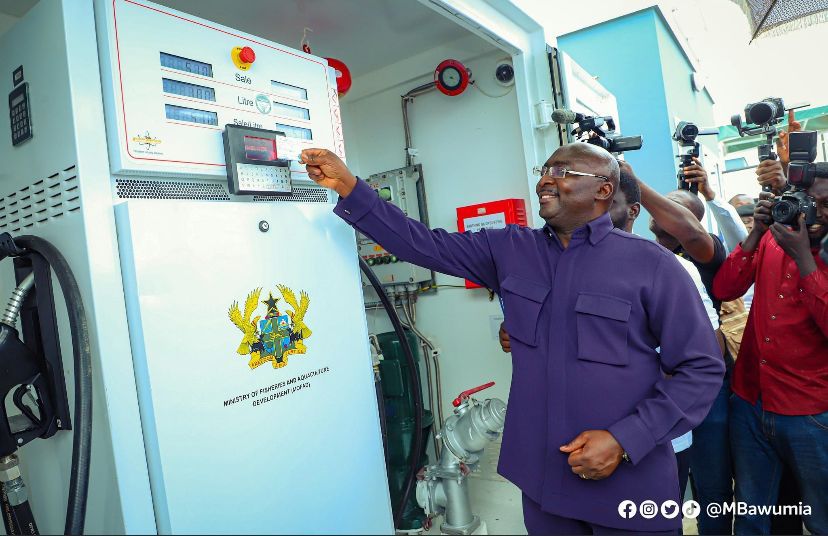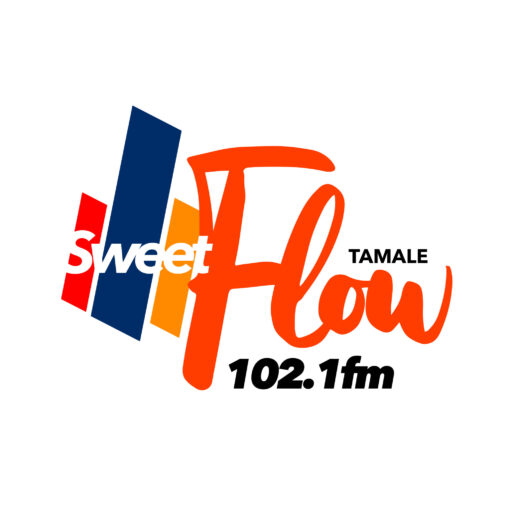Vice President Dr Mahamudu Bawumia Tuesday commissioned the National Premix Fuel Automation Project at Elmina to ensure equity, transparency, and accountability in dispensing and monitoring premix fuel systems.
The automation is expected to complement existing strategies being employed to address the challenges associated with the allocation, distribution, and sale of premix fuel as well as the canoe identification system.
Put together by Fuel Automation Ghana Limited and partners, the fishermen management module will have a database of all fishermen and their respective fleets to handle fuel allocations assigned to each fisherman through the Canoe Identification Card.
Dr Bawumia said the commissioning marked the dawn of a new era of the nation’s fisheries sector with bright hopes to redefine its landscape through public private partnership technological solutions.
He said the integration of cutting-edge technology in the fisheries sector had come with major benefits including easy payments, effective tracking, and payment flexibility to nurture equity, transparency, and accountability.
Moreover, it would serve as an effective solution to deep-seated corruption, political takeovers amidst perennial challenges such as prolonged waiting time, low customer satisfaction, rush hour challenges, the lack of trust and transparency, and general transaction tracking hassles.
These challenges, Vice President Bawumia said, had resulted in shortages, black market activities, diversion, and tricks “Kalabule” in the fisheries’ industry.
He hinted of plans to include mobile money transaction in the premix fuel automation process, adding that “the sector remains key to sustaining livelihoods, social wellbeing of fishers and contributing substantially to sustaining national food security.”
Mrs Mavis Hawa Koomson, the Minister of Fisheries and Aquaculture Development, said the automation of premix fuel would not only stop the diversion of the product but ensure that few individuals did not short-change the State and fishers in the supply and distribution chain.
She said the facility was a comprehensive software solution that encompasses the entire fuelling ecosystem to monitor the data sent from the landing beaches and help the Government understand the consumption patterns to guide policy.
The National Premix Secretariat would access real-time data from their control centre to facilitate forecasting and inventory management, which avoids stock outs.
Through proper logistics management, the data generated would be essential for reordering, whilst each order is carefully monitored and measured against agreed delivery timelines to enhance delivery efficiency thereby drastically reducing stock out.
Nana Kojo Conduah VI, Omanhen of Edina Traditional Area, commended the Government for the numerous infrastructure interventions in the area and pleaded with it to restructure Saiko to better the lots of fishmongers.
The Automation outlet would make recording of transactions at the landing site easier and enhance the tracking of products received and dispensed, ensure safe fuelling and refuelling processes, equity in fuel disbursement, receipt printouts, and fuel reconciliation.
The system consists of dispensing control units, fuel level sensors for monitoring fuel levels, a card utilization system for authorization as well as a web and mobile application for monitoring, controlling and generating reports.
The automated Landing Beach fuel outlets has 15000/30000 litre self-bonded container fuel tank outfitted with proven fuel dispensing and automation technology that has been tested in more than one million tanks across the world.
The outlet hosts a fuel pump for dispensing at 50 litres per minute (50L/Min), a discharge pump for receiving deliveries up to 500 litres per minute (500L/min), a forecourt controller, automatic tank gauging, Payment Reader with NFC, QR CODE, Chip, and Pin and RFID capabilities.
All outlets would have remote access on authorised web-accessible devices, allowing stakeholders to view in real-time all transactions at each landing beach.
Before the automation, basic methods such as buckets and “jerry-cans” were used to deliver fuel to the fishermen, causing breaches in safe fuel handling procedures, arbitrary method of distribution and poor volume accountability.
On safety protocol, the outlet had been designed to meet international marine safety standards and maintenance procedures with features such as a service bay with fall prevention, automatic fire extinguishers, an emergency shut-off system, and a lockable control panel.
There is a lockable manhole with corrosion protection, overfill protection, interstitial inspection hatch for checking leakages, and earthling for the fishermen’s drums for an incident-free fuelling experience.

